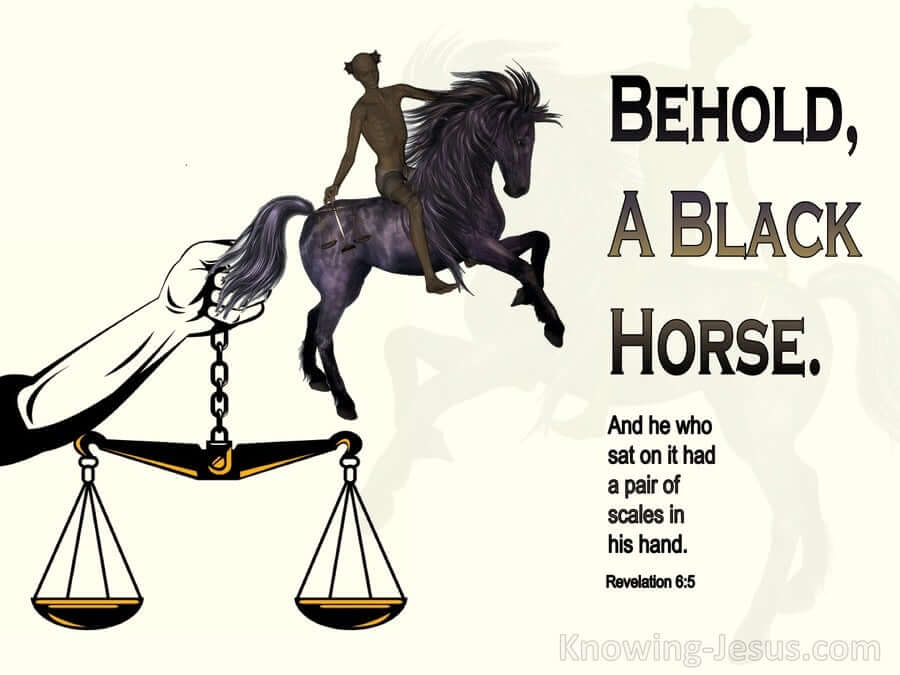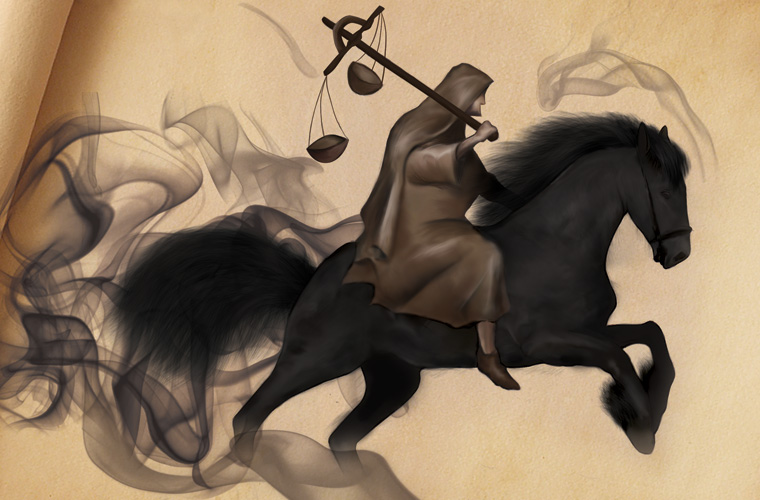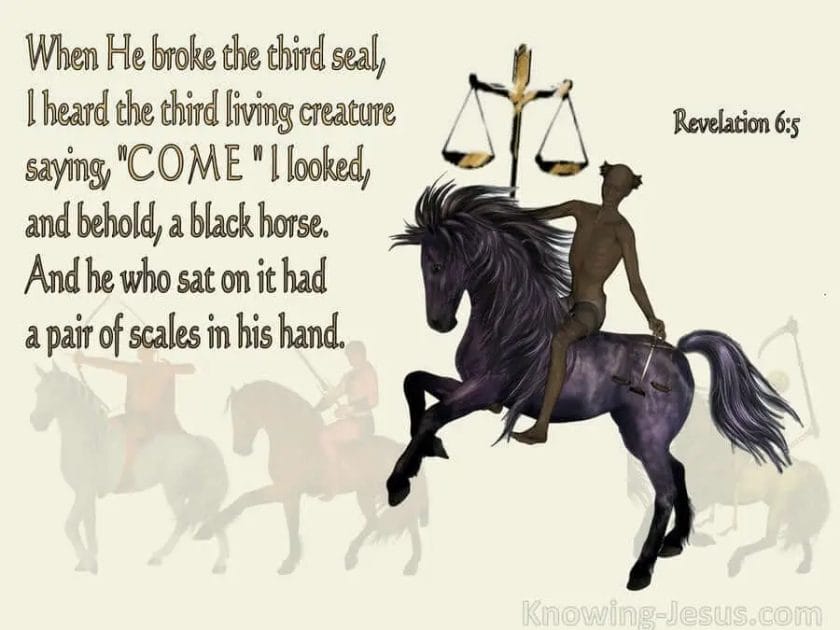The black horse mentioned in the book of Revelation represents famine and scarcity, symbolizing the consequences of economic decline and food shortages. In the biblical text, the horseman rides on a black horse, holding scales in his hand, signifying the pricing and rationing of essential commodities. This apocalyptic image serves as a warning of the hardships that may follow in times of societal upheaval and economic instability.

Understanding the Significance of the Black Horse in Revelation
The book of Revelation in the Bible is known for its apocalyptic imagery and symbolic language. One of the key symbols mentioned in Revelation is the Four Horsemen of the Apocalypse, who are described as riding different colored horses. Each horse and its rider represent a specific aspect of the end times. In this section, we will focus on the significance of the black horse in Revelation.
The black horse is introduced in Revelation 6:5-6, which states, “When the Lamb opened the third seal, I heard the third living creature say, ‘Come!’ I looked, and there before me was a black horse! Its rider was holding a pair of scales in his hand. Then I heard what sounded like a voice among the four living creatures, saying, ‘Two pounds of wheat for a day’s wages, and six pounds of barley for a day’s wages, and do not damage the oil and the wine!'”
The black horse represents scarcity and economic hardship. Its rider is seen holding a pair of scales, symbolizing the careful weighing of food and resources. The voice that is heard indicates the high cost of basic necessities, such as wheat and barley. This scarcity is further emphasized by the instruction not to damage the oil and the wine, which were considered luxuries in biblical times.
The black horse is often associated with famine and economic instability. It signifies a time of scarcity where people will struggle to obtain enough food to sustain themselves. This interpretation aligns with other passages in the Bible that speak about famines as a consequence of sin and judgment.
Furthermore, the black horse can also be seen as a representation of social and economic inequality. The fact that the cost of wheat and barley is disproportionately high compared to other commodities like oil and wine suggests that only the wealthy will be able to afford essential food items. This highlights the stark divide between the rich and the poor during the end times.
It is important to note that the interpretation of the black horse and its symbolism in Revelation is a matter of theological debate. Various scholars and theologians have different perspectives on its meaning. However, the general consensus is that the black horse signifies economic hardship, scarcity, and inequality.
In summary, the black horse in Revelation represents scarcity, economic hardship, and social inequality. Its rider holding a pair of scales signifies the careful allocation of resources, and the high cost of basic necessities like wheat and barley indicates a time of famine. This symbol serves as a warning of the challenges that will be faced during the end times and emphasizes the importance of preparedness and reliance on God.

Decoding the Symbolic Meaning of the Black Horse in the Book of Revelation
The Book of Revelation, the final book of the New Testament, has captivated readers for centuries with its vivid imagery and enigmatic symbolism. Among the many intriguing symbols found in this apocalyptic text is the black horse, which makes its appearance in the third seal. Understanding the symbolic meaning of the black horse is crucial for unraveling the deeper message conveyed by the Book of Revelation.
The Context of the Black Horse
Before delving into the symbolic meaning of the black horse, it is important to understand its context within the Book of Revelation. The black horse is part of a series of seals that represent the unfolding of events leading up to the end times. Each seal reveals a different aspect of this divine plan.
The black horse is introduced in Revelation 6:5-6: “When the Lamb opened the third seal, I heard the third living creature say, ‘Come!’ I looked, and there before me was a black horse! Its rider was holding a pair of scales in his hand. Then I heard what sounded like a voice among the four living creatures, saying, ‘A quart of wheat for a day’s wages, and three quarts of barley for a day’s wages, and do not damage the oil and the wine!'”
The Symbolic Interpretation
The black horse is often associated with famine and scarcity. Its rider holding a pair of scales is a representation of the economic impact of the famine. The voice that speaks in Revelation 6:6 indicates the exorbitant prices of basic food items, such as wheat and barley, which will result in economic hardship for the people.
Moreover, the mention of not damaging the oil and the wine suggests that while there may be scarcity in staple commodities, luxury items will remain intact. This further highlights the economic disparity and the suffering that will accompany the scarcity revealed by the black horse.
Symbolically, the black horse can also represent spiritual darkness and moral decay. In biblical symbolism, black is often associated with sin and evil. The presence of the black horse in the sequence of seals signifies the spiritual challenges and moral corruption that will prevail during the end times.
The Deeper Message
Decoding the symbolic meaning of the black horse in the Book of Revelation provides insight into the larger message conveyed by the text. The black horse represents the consequences of greed, injustice, and spiritual decay that will unfold during the end times. It serves as a warning to humanity about the perils of straying from righteousness and the resulting hardships that will ensue.
Furthermore, the black horse serves as a call to action for believers to remain steadfast in their faith and to resist succumbing to the temptations and moral compromises of the world. It serves as a reminder of the importance of integrity, compassion, and spiritual resilience in the face of adversity.
In Summary
The symbolic meaning of the black horse in the Book of Revelation is multi-faceted. It represents famine, economic hardship, spiritual darkness, and moral decay. The black horse serves as a warning and a call to action for believers to uphold righteousness and resist the temptations of the world. Understanding the symbolic significance of the black horse deepens our understanding of the profound message contained within the Book of Revelation.

Unraveling the Mystery of the Black Horse in Revelation: A Closer Look
Revelation, the final book of the Bible, is known for its vivid imagery and apocalyptic prophecies. Among its many intriguing symbols and visions, one that has captivated scholars and theologians for centuries is the image of the Four Horsemen of the Apocalypse. Each horse represents a different aspect of the end times, and the third horse, the black horse, has sparked particular interest and speculation.
The black horse is introduced in Revelation 6:5-6, where it is described as follows: “And when he opened the third seal, I heard the third living creature say, ‘Come!’ And I looked, and behold, a black horse! And its rider had a pair of scales in his hand. And I heard what seemed to be a voice in the midst of the four living creatures, saying, ‘A quart of wheat for a denarius, and three quarts of barley for a denarius, and do not harm the oil and wine!'”
So, what does this mysterious black horse symbolize? Let’s delve deeper into its meaning and significance in the context of Revelation.
The Symbolism of the Black Horse
The color black is often associated with darkness, mourning, and famine. In the case of the black horse, it represents scarcity and economic hardship. The rider’s possession of a pair of scales symbolizes the careful measuring and rationing of resources, indicating a time of economic turmoil and inflation.
The voice that accompanies the black horse specifies the prices of wheat and barley, two staple food crops. The mention of a denarius, a Roman coin, suggests that these prices represent a significant increase in the cost of daily necessities. The directive to spare the oil and wine further emphasizes the contrast between the economic struggles faced by the general population and the relative abundance enjoyed by the wealthy.
The Interpretations and Theories
Over the centuries, various interpretations have been proposed to explain the symbolism of the black horse. Here are a few notable theories:
- Economic Turmoil: Many scholars view the black horse as a representation of economic hardship and scarcity during a time of crisis. It is seen as a warning of the consequences of greed, inequality, and corrupt economic systems.
- Famine and Food Shortages: Some interpretations suggest that the black horse signifies a time of famine and food shortages. The high prices of wheat and barley imply a scarcity of basic sustenance, leading to hunger and suffering.
- Social and Political Unrest: Another perspective links the black horse to social and political instability. The economic turmoil caused by the scarcity of resources can lead to civil unrest, uprisings, and societal upheaval.
- Symbolic of a Specific Era: Some scholars propose that the Four Horsemen represent different historical periods or events. The black horse may symbolize a specific era marked by economic struggles, such as the Great Depression or other major economic crises.
It is important to note that these interpretations are speculative and should be approached with caution. The symbolism in Revelation is highly symbolic and open to various interpretations.
The Message Behind the Black Horse
Ultimately, the black horse serves as a cautionary symbol, warning of the consequences of societal and economic imbalance. It reminds us of the importance of equitable distribution of resources, justice, and compassion in the face of challenging times.
In summary, the black horse in Revelation represents economic hardship, scarcity, and the careful rationing of resources. It is a symbol of warning and serves as a reminder for us to strive for fairness and justice in our own lives and societies.
Exploring the Biblical Interpretation of the Black Horse in Revelation
The book of Revelation, the last book of the Bible, is known for its vivid imagery and symbolic language. Among its many symbols, one that stands out is the black horse. In the sixth chapter of Revelation, the apostle John describes a vision in which he sees four horsemen, each riding a different colored horse. The black horse is the third horse, and its rider holds a pair of scales in his hand. But what does this black horse symbolize in biblical interpretation? Let’s delve deeper into its meaning.
The Symbolism of Colors in the Bible
Colors play a significant role in biblical interpretation. They are often used symbolically to convey deeper spiritual meanings. In the case of the black horse, the color black typically represents famine, mourning, and distress. In various other passages throughout the Bible, black is associated with darkness, sin, and judgment. Therefore, the presence of the black horse in Revelation signifies a time of scarcity, hardship, and judgment.
The Famine and Economic Distress
When we examine the text in Revelation, the black horse is accompanied by a statement that the rider carries a pair of scales. This symbolizes the measurement of food and its distribution. The black horse’s appearance suggests a period of famine and economic distress. It signifies a scarcity of resources, leading to inflated prices and hunger among the people.
This interpretation aligns with the context of the first-century audience to whom the book of Revelation was primarily addressed. The early Christian community faced persecution and economic challenges under the Roman Empire. The symbolism of the black horse would have resonated with their experiences of scarcity and hardship.
Social and Spiritual Implications
Understanding the symbolism of the black horse also carries social and spiritual implications. The scarcity and economic distress depicted by the black horse remind believers to seek their sustenance and security in God rather than placing their trust in worldly systems. It serves as a call to remain faithful and steadfast in the face of difficult circumstances.
Interpretive Diversity
While the above interpretation provides a common understanding of the black horse, it is important to note that biblical symbolism allows for a degree of interpretive diversity. Some scholars have proposed alternative explanations based on historical and cultural contexts. However, the overall consensus revolves around the themes of famine, scarcity, and distress.
In summary, the black horse in the book of Revelation symbolizes famine, economic distress, scarcity, and judgment. Its appearance serves as a reminder for believers to rely on God’s provision and remain faithful during challenging times. While specific interpretations may vary, the overall message remains the same – trust in God’s sovereignty even in the face of scarcity and hardship.
FAQs
1. What does the black horse in Revelation represent?
The black horse in Revelation represents famine and scarcity. It symbolizes a period of economic hardship, where basic resources like food and necessities become scarce and expensive.
Conclusion:
In conclusion, the black horse mentioned in the book of Revelation holds symbolic significance. It represents famine, scarcity, and economic turmoil. This image serves as a warning of the consequences of human greed and mismanagement. The black horse’s presence in Revelation conveys a message about the fragility of the global economy and the need for responsible stewardship of resources. It is a reminder to prioritize sustainability and equitable distribution of wealth. Understanding the symbolism behind the black horse helps us to reflect on the importance of balance, justice, and compassion in our economic systems.
